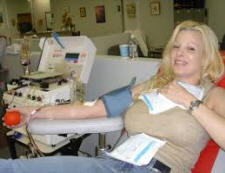
Plasma Exchange
This information is written especially for patients like yourself who may be exposed to plasmaExchange as a treatment option. Use this information to help set a framework of assisting you with your discussions with your the medical providers to help you understand this safe, simple, and routine procedure and what it will involve. Please discuss the information below with your health care providers.
The following four questions will be answered:
1. What is plasma?
2. What is plasma exchange?
3. Why is plasma exchange necessary?
4. What actually happens during a plasma exchange procedure?
What is Plasma?
Plasma is the fluid portion of the blood that allows the circulation of red blood cells, white blood cells, and
platelets. It consists mainly of water in which numerous compounds are dissolved.
Plasma also makes possible chemical communication among different parts of the body by carrying minerals, hormones, vitamins, and antibodies. Normal plasma has a yellow color when it is observed
through a test tube or bag where blood has settled.
What is Plasma Exchange?
Plasma Exchange is a patient procedure involving the separation and removal of the plasma from the blood in order to remove a disease substance circulating in the plasma. The red blood cells, white blood cells, and platelets are returned to the patient, along with a prescribed replacement fluid. Simply stated, the “old plasma” is removed and replaced by the “new plasma.” In other words, a PLASMA EXCHANGE took place.
Why is Plasma Exchange Necessary?
Some diseases create substances which circulate throughout the body in the plasma portion of the blood and which may attack healthy cells or tissue. These substances are created by a mix-up in the body’s immune system. Other diseases cause an overproduction of the substances which results in slowing down the blood flow (in the same way that thick liquids move more slowly than thin ones). A physician will decide if it is desirable to remove a large quantity of the substances with a plasma exchange so that the accompanying medication is more effective in controlling the disease. The plasma is replaced with donated fresh frozen plasma or, more commonly, physiologically acceptable replacement fluids, such as a mixture of albumin and normal saline.
What actually happens during a Plasma Exchange Procedure?
Plasma exchange is accomplished with a medical device called a blood cell separator; the COBE® Spectra™ Apheresis System is such a device. It uses a centrifuge to separate plasma from cellular blood components. Qualified medical personnel operate the blood cell separator and monitor the condition of the patient at all times. Blood is drawn from a patient’s arm vein by a needle which is attached to a blood tubing set. Anticoagulant is added to the blood to keep it from clotting. The blood and anticoagulant enter the compartment of the blood cell separator where the plasma is separated from the cellular components and pumped into a collection bag. The cellular components are drawn from the compartment and a replacement fluid prescribed by the physician is added to replace the volume of plasma which is removed. The mix of cellular components and replacement fluid is returned to the patient, through a needle in the other arm. The blood cell separators accomplish all the above steps in an automated, continuous, and safe manner.